Numerical study on peak current in pulsemodulated radio-frequency discharges with atmospheric helium–oxygen admixtures
Xucheng WANG(王绪成),Shuhan GAO(高书涵)and Yuantao ZHANG(张远涛)
School of Electrical Engineering,Shandong University,Jinan 250061,Peopleʼs Republic of China
Abstract Atmospheric pressure pulse-modulated radio-frequency (rf) plasmas have drawn growing attention due to their potential in applications.By selecting appropriate modulation parameters,the diffused and large-volume plasma can be generated in the pulse-modulated rf plasma with plenty of reactive oxygen species,which is essential for the biomedical application of helium–oxygen plasmas.In this paper,by means of a fluid model,the formation of the peak current in the first period (PCFP) in a pulse-modulated rf helium–oxygen discharge driven by a sinusoidal voltage is discussed,the existence of a reverse field near the anode caused by the negative and positive charges contributes greatly to the mechanism of PCFP.In the simulation,as oxygen admixture increases,the negative ions of O−and O2−become dominative anions in the sheath region,which can’t be driven to the anode very quickly to build a reverse field,thus the PCFP eventually disappears.This study can effectively enhance the understanding of different transportation behavior of heavy negative ions and electrons,and further optimize pulsemodulated rf discharges with helium–oxygen mixtures in various applications.
Keywords: pulse modulation,RF discharge,fluid model
1.Introduction
During the past decades,owing to the wide application fields and lower costs,atmospheric pressure plasmas have been greatly developed [1–5].Compared with low-pressure plasmas,atmospheric plasmas are easy to apply and do not require expensive vacuum equipment,which is very essential for the application of plasmas in the materials and environments [6,7].The atmospheric capacitively coupled radiofrequency (rf) discharges could produce the stable largevolume plasmas in α mode without the dielectric barriers,and high-density active species are generated through the frequent multi-body collisions in the rf plasmas,which is of great significance for the application of plasma biomedical,such as wound healing,tissue regeneration,and so on [8–10].However,when more energy is coupled into the atmospheric rf plasmas,the transition of discharge from the α mode to the γ mode will be observed,and the hot and constricted plasmas can be generated,together with the increase of the gas temperature,leading to reduced device longevity in industrial applications [11–13].Therefore,in most applications of atmospheric pressure rf plasmas,it is always desirable to operate discharges in α mode and avoid the transition to γ mode [14,15].
The application of pulse-modulated technology enables the rf plasma to be only generated during the power-on phase and the mode transition from α mode to γ mode will be delayed.At the same time,by selecting the suitable duty cycle and modulation frequency,the pulse-modulated rf discharges can be further optimized for applications,and the electron density and electron energy still maintain higher while reducing the power consumption [16].The atmospheric pulse-modulated rf discharges could lead to new discharge characteristics in the range of very high frequency (VHF),even in the range of ultra-high frequency (UHF).During the first period of the pulse-modulated rf discharges in the poweron phase,a very strong peak current can be observed [17].Plenty of energetic electrons with an energy of more than 50 eV have been produced in the PCFP [18].When other gases,such as oxygen,are admixed to the discharge gas of helium,a large number of reactive particles could be obtained in the atmospheric pressure rf plasmas.These reactive particles are found to play essential roles in biomedical applications[11,19].In the previous study,the optimization of the atmospheric rf discharge of helium–oxygen plasmas at a normal frequency of 13.56 MHz was analyzed using a numerical simulation [20].However,less attention has been paid to the discharge characteristics of helium–oxygen plasmas under atmospheric pressure when the rf frequency reaches the VHF range,and plenty of energetic electrons produced during the first period by pulse-modulated rf discharge are also critical for the formation of reactive oxygen species.Therefore,the formation mechanism of PCFP in helium–oxygen plasmas should be further understood,and the effects of different oxygen admixtures on PCFP should be discussed.
This work focuses on the generation mechanism of the PCFP in helium–oxygen plasmas produced by pulse-modulated rf discharges.The second section is concerned with the description of the mathematical model used for this study.The third section gives the findings of the mechanism of the PCFP in pulse-modulated rf helium–oxygen discharges,and the effect of oxygen admixture on the PCFP is also investigated in the third part according to the simulation data.In the fourth section,a conclusion is summarized.
2.Description of the model
A one-dimensional fluid model is applied in this work to investigate the discharge mechanism of atmospheric pulsemodulated rf discharges.The production and destruction of various particles are given by the continuity equations

where the indices e,a,i,and n are electrons,negative ions,positive ions,and neutral particles,N is the density of various particles,S refers to the source item of particles,respectively.Γ is the flux of particles calculated by the diffusion-drift approximation,which is expressed as

where μ and D denote mobility and diffusion coefficients of various particles.Both drift and diffusion are considered for charged species,while only diffusion is taken into account for neutral species.The transportation coefficient of electrons was computed using the Boltzmann equation solver based on the collision cross-section data from the Phelps database in the LXCat website [21].The mobilities of ions related to oxygen species were given from references [22,23],and the corresponding diffusion coefficients of ions are calculated from mobility using Einstein relation[24].The diffusion coefficients of neutral species related to oxygen species were given from reference [25].The transportation coefficients of helium were mainly obtained from references[26,27],E is the electric field in the discharge region,which is calculated by the Poisson equation given as ∇ ·E=
In this model,the current balance equation shown in equation (4) can be derived by performing the time differentiation on both sides of the Poisson equation [27–29].

where ε0represents the vacuum permittivity,j0and jgare the total current density and the conduction current density.j0is given by equation (5) and jgis expressed as equation (6).

where d is the electrode spacing,V is the applied voltage given by equation (7),e is the elementary charge.The electron energy conservation equation can accurately calculate the electron temperature,which is expressed in references [26,29].
In the simulation,the applied voltage is given as a piecewise function,which includes the power-on phase(denoted as Pon)and power-off phase(denoted as Poff)in equation(7),respectively.

where V0is the amplitude of the sinusoidal applied voltage fixed as a constant of 200 V during the power-on phase,f is the rf frequency,r refers to the voltage modulation rate(VMR)changing from 0%to 100%,that is the ratio of voltage amplitude between the power-on phase and power-off phase.In this paper,the VMR is fixed as 15%to ensure the stability of the simulation.T′,as the sum of Ponand Poff,is the entire pulse modulation period,the corresponding modulation frequency and duty cycle are calculated byf′=1T′andD=Pon× 100T′.
As the driving frequency reaches several hundred MHz,the simulation data calculated by the fluid model match the computational data well,obtained from the particle-in-cell Monte Carlo collision (PIC-MCC) model in references[30,31].Therefore,the fluid description could still capture the main discharge characteristics with the driving frequency ranging from tens of MHz to hundreds of MHz [32–34].In the present helium–oxygen plasma model,17 species and 65 important chemical reactions were considered.The reaction set can be obtained from the previous studies in reference[20],which are mainly from the zero-dimensional simulation at the atmospheric helium–oxygen plasma [35,36],and by comparing with the experimental results,the reaction set used has been validated in reference [16].In addition,the simulation results in the previous work based on these species and reactions are consistent with the experimental results[11,19,37].In this work,the model consists of four neutral particles(He,O,O2,and O3),eight charged particles(e,He+,He2+,O+,O2+,O−,O2−,and O3−),and five excited particles,which are denoted as He*(helium metastable atom),He2*(helium excimer molecule),O (1D) (excited atomic oxygen),O2(1Δg)(single delta metastable oxygen),and O2(1Σg+)(single sigma metastable oxygen).The plasma source consists of two parallel plate electrodes,and the electrode spacing is fixed as 300 μm,which is filled with atmospheric pure helium and oxygen impurity.Except for the helium and oxygen molecules,the other particles have a uniform distribution with an initial density of 1.0×108cm−3,more details on the chemical reactions and the model parameters can be found in reference[20,38].The secondary electron emission is fixed at 0.03,which is treated as an important boundary condition of ions in the model [27,39].When the atmospheric pressure rf discharge is operated in α mode,the gas temperature changes very slightly and it is fixed at 350 K.
3.Results and discussion
In the pulse-modulated rf discharge,the PCFP can be observed by rising the excitation frequency to the VHF range,even in the UHF range,which has been discussed in previous studies[40–42].In the first rf period of the pulse-modulated rf discharge,many energetic electrons could be obtained,essentially attributed to the generation of reverse electric field near the anode.As we know,the continuous rf discharges usually can only produce electrons with medium energy[41],and in the helium–oxygen plasmas,energetic electrons play a crucial role in the generation of reactive oxygen species.In this work,a pulse-modulated rf voltage with an excitation frequency of 500 MHz and a modulation frequency of 6.25 MHz is served as the power source,figure 1 presents the evolution of current density at a sinusoidal voltage amplitude of 200 V,an oxygen admixture of 0.5%,and a duty cycle of 70%.In the first rf period of the power-on phase,a remarkable peak current is generated.The value of the PCFP is 10.1 A cm−2,which is 11.1% greater than those in the rest periods only of 9.1 A cm−2during the power-on phase.In the rest of the rf periods,the PCFP will not be observed,which shows a different discharge pattern from the usual pulse-modulated rf discharges with the excitation frequency of 13.56 MHz[16,43,44].
To better understand the formation mechanism of the PCFP,figure 2 shows the spatial profiles of positive and negative charge densities at different moments.It can be noted that in figures 2 and 3,T1is the moment when the first rf period starts during the power-on phase,that is,at this moment,the applied voltage is zero and then it begins to grow.T2and T3are the moments when the current density reaches the positive peak value in the first and second rf periods during the power-on phase,respectively.As shown in figure 2(a),the distribution of positive and negative charge densities is almost completely symmetrical.According to the previous study [38,45],the positive ions are mainly O2+,and the negative ions are mainly O−.Because of the rapid wall losses of electrons,the density of electrons near the electrode surface is lower,which results in a lower density of total negative charges in the sheath region than that of positive charges,and the spatial profile of the corresponding electric field at the moment of T1is seen in figure 3(a).An electric field with a peak value of 9.6 kV cm−1is observed in the cathode sheath region,and the negative electric field in the anode sheath region reaches −15.4 kV cm−1.As presented in figure 3(a),it is clear that the O−ions in the bulk plasma region are the most abundant negative charges,but electrons as the negative particles in the anode and cathode sheath region have the highest density partly because of its large mobility.O2+ions are the main component of the positive changes throughout the discharge region.Then,figure 2(b)gives the spatial profiles of positive and negative charge densities at the moment of T2.When the sinusoidal voltage with a driving frequency of 500 MHz is applied,a lot of electrons are driven by an applied electric field to the anode,but these electrons cannot reach the electrode before the breakdown event due to the rapid rise phase of the applied voltage.At the same time,the change of ions could be ignored since it is difficult for positive and negative ions to follow the fast changes of the applied electric field.Thus,a lot of electrons will sustain between the anode and the bulk plasma region,resulting in the density of negative charges near the anode being greater than that of positive charges.Figure 3(b)shows the corresponding electric field,an induced reverse electric field of 8.6 kV cm−1in the anode sheath is built,which shows the same polarity as that of 33.4 kV cm−1in the cathode region according to the simulation results.The spatial distribution of the electric field at the instant of T2is obviously different from that at the instant of T1.Therefore,the reverse electric field will effectively accelerate the electrons to obtain more energy,playing a significant role in the formation of the PCFP.The distribution of positive and negative charge densities at the moment of T3is shown in figure 2(c).At the instant of T3,both in the anode and cathode sheath region,the positive charge density is larger than that of negative charges.The corresponding stronger electric field of 48.8 kV cm−1at the instant of T3can be formed near the cathode,and a lot of electrons are continuously driven to the anode and absorbed by electrodes,so the reverse electric field cannot be obtained near the anode,as presented in figure 3(c),which is very similar to the electric field distribution driven by the continuous power supply.Therefore,it is believed that the distribution of the electric field is favorable to the production of the PCFP in atmospheric helium–oxygen discharge driven by pulse-modulated rf voltages.
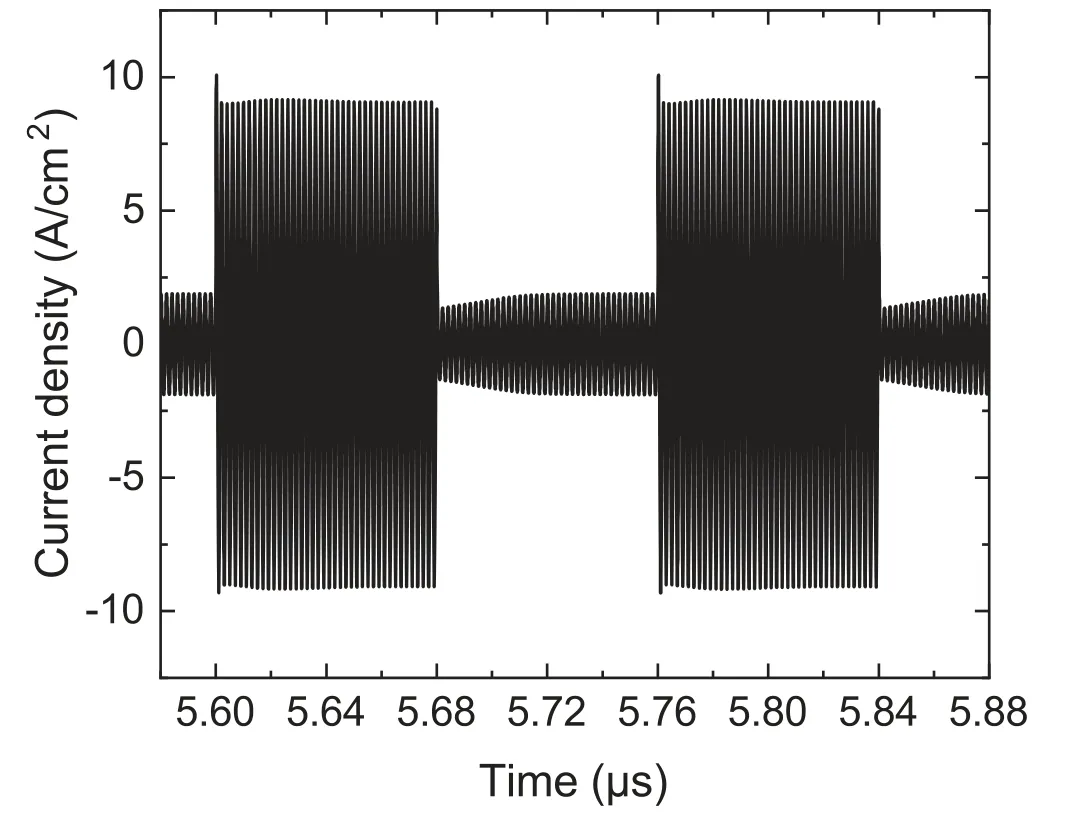
Figure 1.Temporal evolution of current density in a pulse-modulated rf He/O2 discharge with a voltage amplitude of 200 V,an oxygen admixture of 0.5 %,and a duty cycle of 70%.
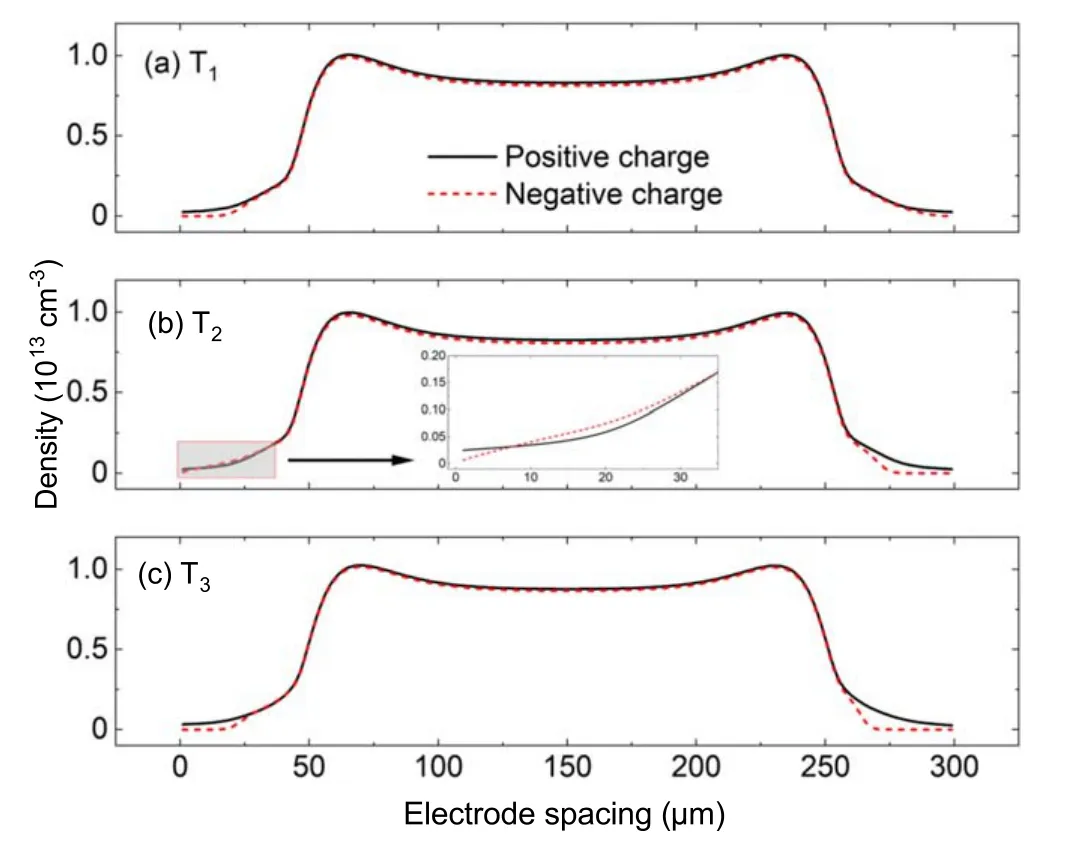
Figure 2.Spatial profiles of the density of positive and negative particles for various instants of T1 (a),T2 (b),and T3 (c).
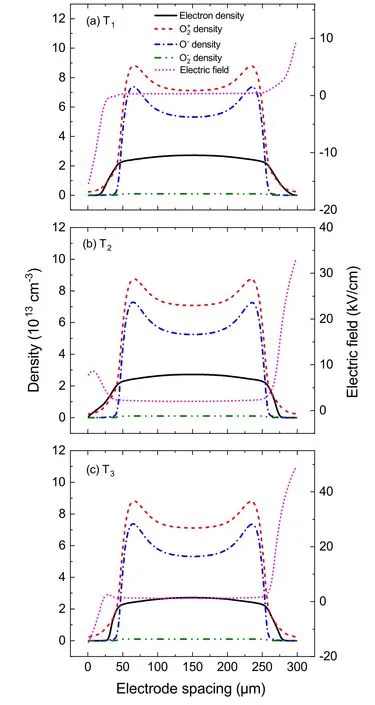
Figure 3.Spatial distribution of the density of main ions and electric field for various instants of T1 (a),T2 (b),and T3 (c).
Figure 4(a) shows the profile of electron temperature at the moment when the current density reaches the peak value during the first rf period.It is obvious that the electron temperature near the anode reaches 6 eV.The reverse electric field near the anode shown in figure 3(b)could accelerate the electrons,enhancing the electron energy.These electrons with higher energy contribute to the formation of the PCFP.In addition,the electron flux is given in figure 4(b).As shown in figure 4(b),the electron flux in the anode sheath region is approximately 1019cm−2s−1,which is much greater than the electron flux of about 1016cm−2s−1in the cathode sheath region.Moreover,the flux of electrons in the anode sheath is much larger than that of negative ions,indicating that the reverse electric field formed near the anode is caused by the fast movement of electrons rather than ions to the vicinity of the anode.
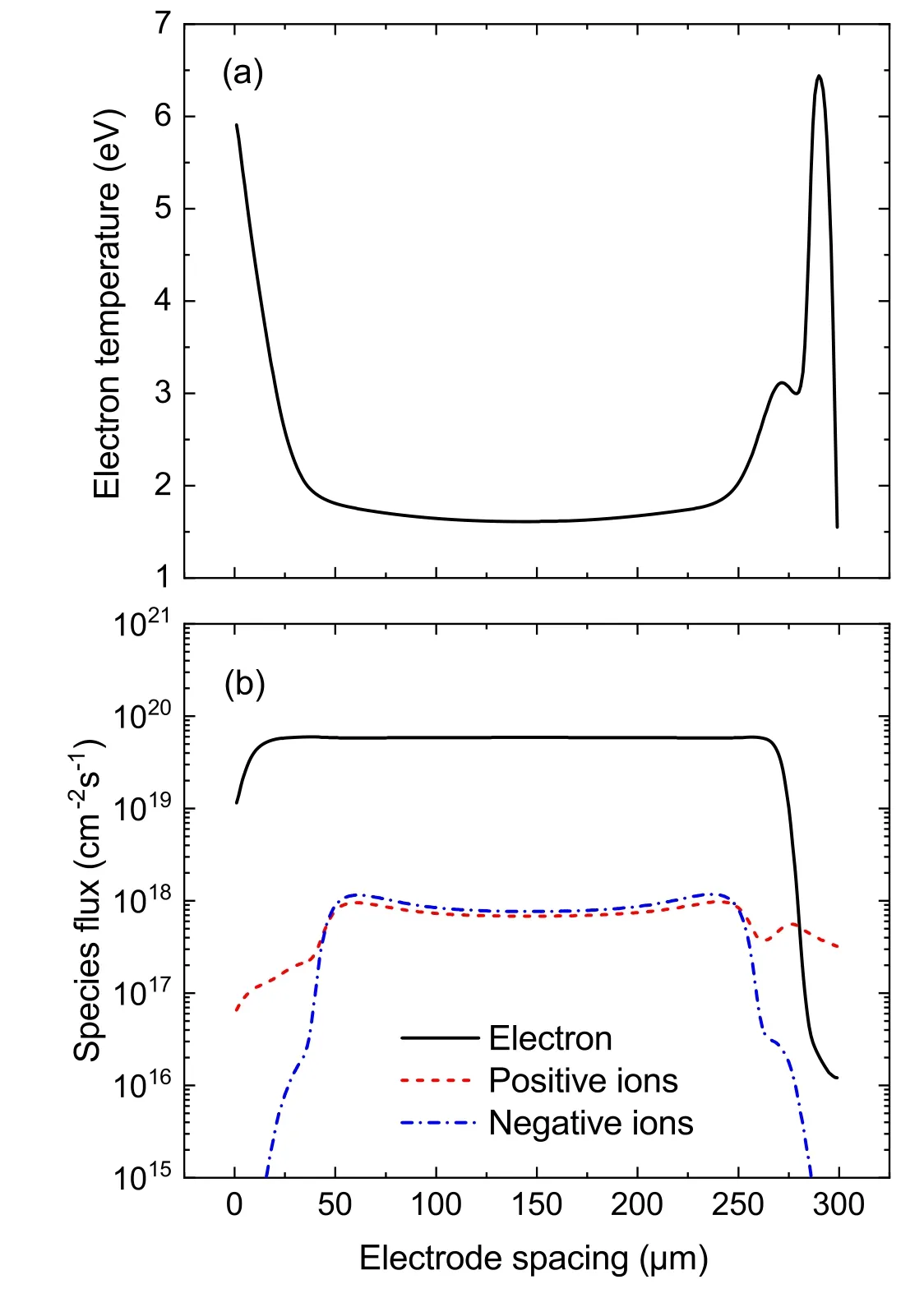
Figure 4.Spatial distribution of the electron temperature (a) and species flux (b) at the moment when the current density reaches the peak value during the first rf period.
Consequently,the formation of the PCFP in helium–oxygen plasmas could be attributed to the following aspects.On one hand,the rf frequency should be increased to the VHF range,so that the voltage or electric field could be greatly enhanced during a very short duration.In this work,driven by a sinusoidal voltage with a voltage amplitude of 200 V and a rf frequency of 500 MHz,the average voltage rising rate of a quarter cycle of the whole period is 400 V ns−1.The gas voltage will rise rapidly and reach its maximum,afterwards it drops sharply and rises conversely,which will drive electrons to sustain between the anode and the bulk plasma region.In addition,the heavier positive and negative ions in the plasma could not respond to the fast changes of the applied electric field at the VHF range and will remain in the bulk plasma region,producing a reverse electric field near the anode.The electrons between the anode and the bulk plasma region could be reheated by the reverse electric field,leading to the formation of the PCFP.This is why the excitation frequency in the simulation is chosen to be a very high-frequency range of 500 MHz.
On the other hand,the presence of a reverse electric field and the initial spatial distribution of the charged species are also key factors for the PCFP generation.As shown in figures 1 and 2,the first rf period is excited at the same frequency as the rest periods,but the peak current is observed only in the first rf period.The reason is that there is a reverse electric field in the first rf period,but not in the rest periods.From the foregoing discussion,driven by the excitation frequency in the VHF range,electrons will accumulate between the anode and the bulk plasma region,causing the density of negative charges near the anode to be larger than the density of positive charges,generating a reverse electric field.This electric field will reheat the electrons and increase the energy of the electrons,which is an essential factor in the formation of a large peak current.
In previous studies,the appropriate modulation parameters such as duty cycle,modulation frequency,and rf frequency can effectively optimize the pulsed-modulation rf discharge to improve the discharge stability and power efficiency [40].With the growth of the duty cycle,the value of PCFP initially ascents and reaches the maximum,then decreases.Finally,when the duty cycle is 100%,the PCFP cannot be formed,which suggests that the PCFP can only be generated in pulse-modulated discharges.A more detailed analysis of the parameters such as the duty cycle has been explained in simulations of reference [17].When the rf frequency is fixed as a constant,the value of PCFP will decrease as the modulation frequency increases.Moreover,by increasing the VMR,the rf discharge becomes completely continuous and the value of the PCFP gradually decreases,until the PCFP finally disappears [41].
The admixture of electronegative gas can also seriously influence the formation of the PCFP.Figure 5 presents the evolution of current density when the oxygen admixtures are 0.1%(a),0.5%(b),1.0%(c),and 3.5%(d).With the increase of oxygen admixture from 0.1% to 3.5%,the peak current during the first rf period is no longer noticeable,and the PCFP also drops or even disappears.The maximum value of the PCFP is 10.6 A cm−2and the peak value of the stable current density is 9.0 A cm−2at the duty cycle of 70% and the oxygen admixture of 0.1%,given in figure 5(a).When the oxygen admixture increases to 0.5%,the maximum value of the PCFP decreases to 10.1 A cm−2shown in figure 5(b).As the oxygen admixture continues to increase,figure 5(c) presents the value of the PCFP of approximately 9.1 A cm−2when the oxygen admixture is 1.0%.However,in figure 5(d),when the oxygen admixture increases to 3.5%,the PCFP is not observed,and the maximum value of current during the first rf period is only 5.0 A cm−2.

Figure 5.Temporal evolution of current density for various oxygen admixtures of 0.1% (a),0.5% (b),1.0% (c),and 3.5% (d).
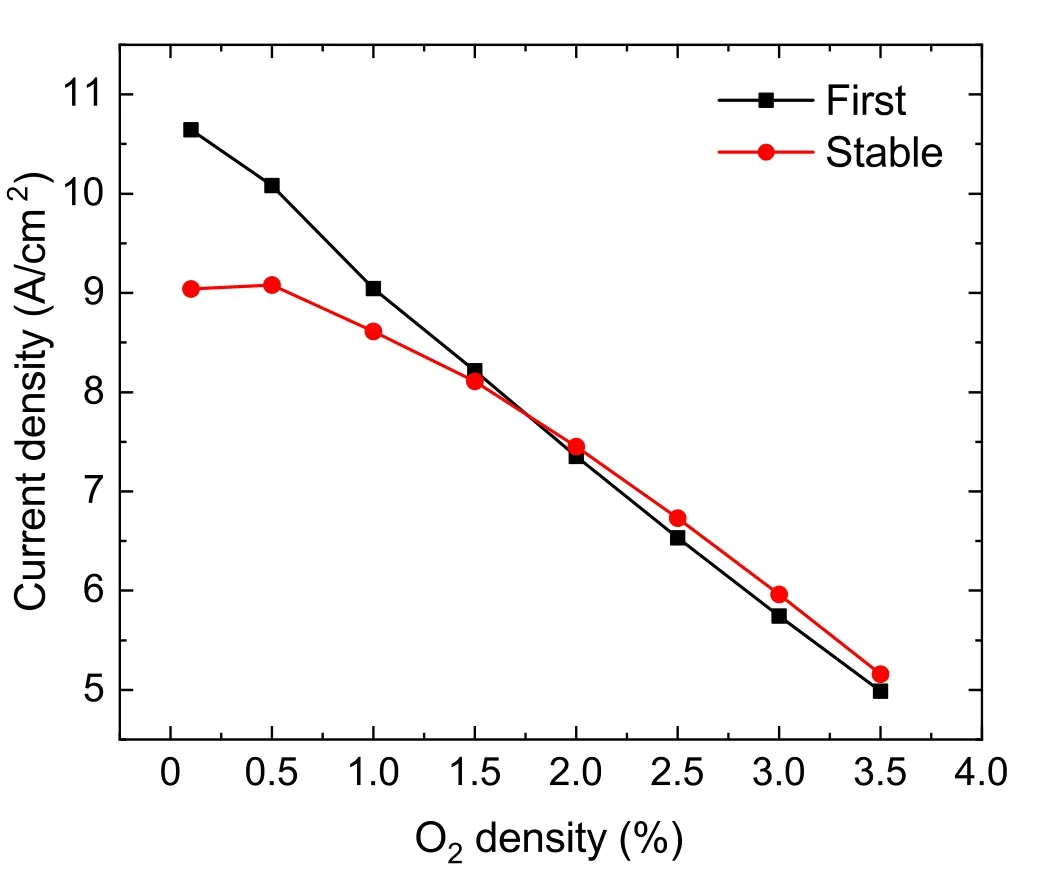
Figure 6.Peak current density as a function of oxygen admixture in the first period and the rest periods.
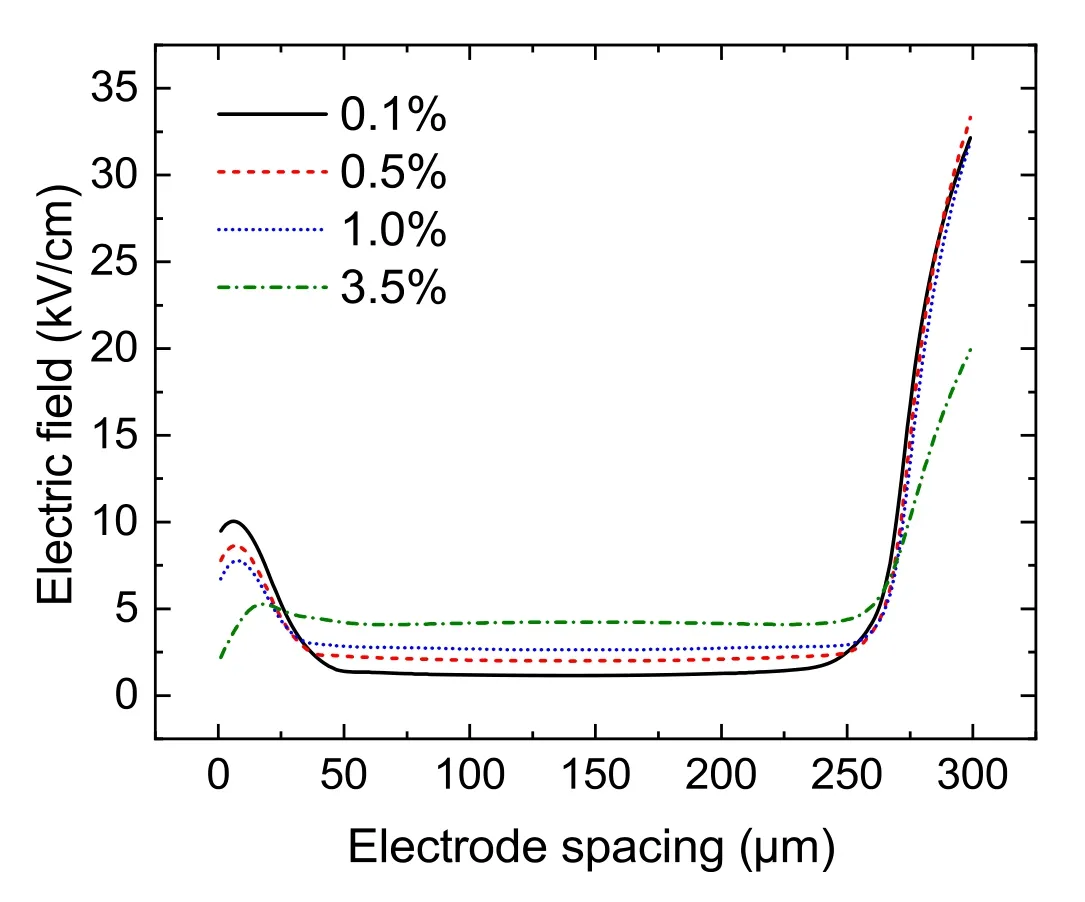
Figure 7.Spatial profiles of electric fields at the moment when the current density reaches the maximum for various oxygen admixtures.
According to the computational data,figure 6 summarizes in detail the dependence of the value of PCFP on the oxygen admixture,as well as the peak current density in the rest stable rf periods.As shown in figure 6,the maximum value of the PCFP is observed when the oxygen admixture is as large as 0.1%.As the oxygen concentration increases,the value of PCFP and the maximum current density in the rest stable rf periods are both decreasing.Due to the electronegativity of oxygen,the rise of oxygen admixture causes a large number of electrons to be adsorbed by molecular oxygen,and the pulse-modulated rf discharge becomes more electronegative,leading to the decrease of electron density in the discharge region,meanwhile the negative ions of O−and O2−with smaller mobility(the mobilities of O−and O2−in He are 28.5 and 21.7 cm2V−1s−1according to references[22,23],while the electron mobility is 878.5 cm2V−1s−1calculated by Bolsig+[24]) become the dominant negative particles [20].As the electron density decreases,only fewer electrons could be driven to the vicinity of the anode by the applied electric field,while the negative ions cannot respond to the field,resulting in a weaker electric field near the anode.Consequently,the value of PCFP eventually decreases with oxygen admixture.
To give a more detailed description,figure 7 presents the spatial profiles of electric field at the instant when the current density in the first rf period gets to the maximum for various oxygen admixtures.According to the spatial profiles of the electric field in figure 7,the electric field in the bulk plasma region increases with the growth of oxygen concentration,and the thickness of the anodic sheath decreases gradually.When the oxygen admixtures are 0.1%,0.5%,and 1.0%,the reverse electric fields near the anode are 10.0,8.6,and 7.8 kV cm−1from the simulation.This qualitatively indicates that the increase of oxygen concentration can effectively weaken the reverse electric field near the anode.More electrons in the discharge space have been attached by molecular oxygen with the increase of oxygen concentration,thus resulting in a reduction of the density of electrons driven to the vicinity of the anode.As a result,the reverse electric field generated near the anode is eventfully reduced.
As the oxygen admixture reaches 3.5%,the reverse electric field near the anode is no longer observed and the PCFP is not obtained.Figure 8 presents the spatial distribution of the density of main species and electric field at an oxygen admixture of 3.5%,a duty cycle of 70%,and an applied voltage of 200 V.Compared with the distribution of main particles density at the oxygen concentration of 0.1%at the instant of T2,shown in figure 3(b),the densities of electrons and various ions decrease significantly,caused by the addition of electronegative gases[20].Although the electrons near the anode are still the main component of negative charges,the electrons density is already lower than the positive ions density,and a reverse electric field with the same polarity as that near the cathode cannot be formed.The importance of the reverse electric field for the formation of peak current has been emphasized in the foregoing discussion.Therefore,the PCFP is not observed when the oxygen admixture is 3.5%.

Figure 8.Spatial profiles of the density of main ions and electric field at the moment when the current density gets to the maximum at an oxygen admixture of 3.5%,a duty cycle of 70%,and an applied voltage of 200 V.
4.Conclusion
In summary,a fluid model is performed to study the formation of the PCFP in atmospheric pulse-modulated rf discharges with admixture gas of helium and oxygen as the working gas.The numerical data show that when the rf frequency and the modulation frequency are 500 MHz and 6.25 MHz,a PCFP with the value of 10.1 A cm−2could be observed during the power-on phase of helium–oxygen discharges.When a sinusoidal voltage with a larger excitation frequency even in the range of the UHF,is applied to the admixture gas of helium and oxygen,the electrons are driven to the anode by the applied electric field and stay between the anode and the bulk plasma region,forming a reverse electric field near the anode,the electrons near the anode could be reheated to form the PCFP.However,with the increase in oxygen impurity the negative ions of O−and O2−eventually become the dominant anions in the sheath region and these heavy ions are hard to quickly respond to the applied field,and the PCFP cannot occur anymore.This study can deepen the understanding of the dynamic behaviors of negative ions and electrons at atmospheric pressure,and the appropriate modulation parameters,such as the oxygen admixture in the helium and oxygen gas,should be carefully selected to optimize the various applications of the pulse-modulated rf discharges.
Acknowledgments
This work was supported by National Natural Science Foundation of China (No.11975142).
 Plasma Science and Technology2022年8期
Plasma Science and Technology2022年8期
- Plasma Science and Technology的其它文章
- Image-based plasma morphology determination and LIBS spectra correction in combustion environments
- Rapid identification of volatile organic compounds and their isomers in the atmosphere
- Fast identification of mural pigments at Mogao Grottoes using a LIBS-based spectral matching algorithm
- Aqueous ruthenium detection by microwaveassisted laser-induced breakdown spectroscopy
- Effect of lens-to-sample distance on spatial uniformity and emission spectrum of flat-top laser-induced plasma
- Quantitative analysis of the main components in ceramic raw materials based on the desktop LIBS analyzer
